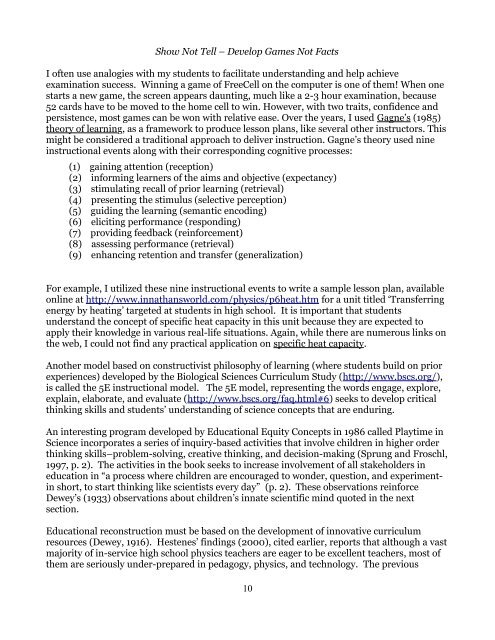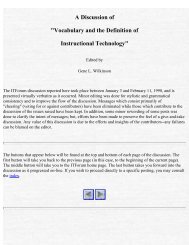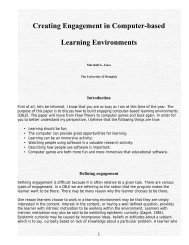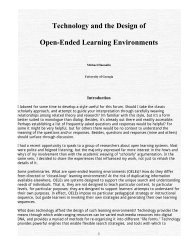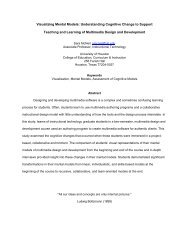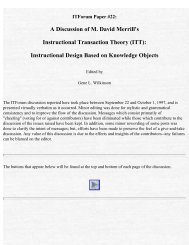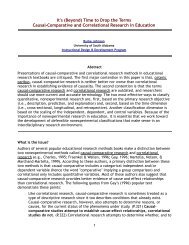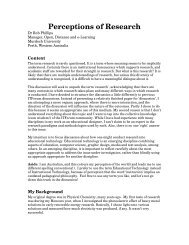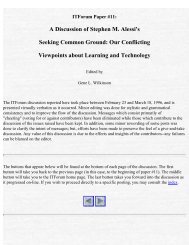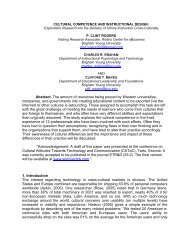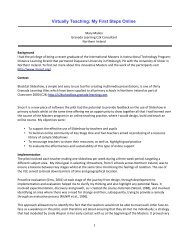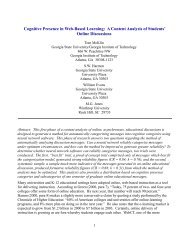SMART EDUCATION: BLENDING SUBJECT EXPERTISE WITH THE CONCEPT OF ...
SMART EDUCATION: BLENDING SUBJECT EXPERTISE WITH THE CONCEPT OF ...
SMART EDUCATION: BLENDING SUBJECT EXPERTISE WITH THE CONCEPT OF ...
You also want an ePaper? Increase the reach of your titles
YUMPU automatically turns print PDFs into web optimized ePapers that Google loves.
Show Not Tell – Develop Games Not Facts<br />
I often use analogies with my students to facilitate understanding and help achieve<br />
examination success. Winning a game of FreeCell on the computer is one of them! When one<br />
starts a new game, the screen appears daunting, much like a 2-3 hour examination, because<br />
52 cards have to be moved to the home cell to win. However, with two traits, confidence and<br />
persistence, most games can be won with relative ease. Over the years, I used Gagne’s (1985)<br />
theory of learning, as a framework to produce lesson plans, like several other instructors. This<br />
might be considered a traditional approach to deliver instruction. Gagne’s theory used nine<br />
instructional events along with their corresponding cognitive processes:<br />
(1) gaining attention (reception)<br />
(2) informing learners of the aims and objective (expectancy)<br />
(3) stimulating recall of prior learning (retrieval)<br />
(4) presenting the stimulus (selective perception)<br />
(5) guiding the learning (semantic encoding)<br />
(6) eliciting performance (responding)<br />
(7) providing feedback (reinforcement)<br />
(8) assessing performance (retrieval)<br />
(9) enhancing retention and transfer (generalization)<br />
For example, I utilized these nine instructional events to write a sample lesson plan, available<br />
online at http://www.innathansworld.com/physics/p6heat.htm for a unit titled ‘Transferring<br />
energy by heating’ targeted at students in high school. It is important that students<br />
understand the concept of specific heat capacity in this unit because they are expected to<br />
apply their knowledge in various real-life situations. Again, while there are numerous links on<br />
the web, I could not find any practical application on specific heat capacity.<br />
Another model based on constructivist philosophy of learning (where students build on prior<br />
experiences) developed by the Biological Sciences Curriculum Study (http://www.bscs.org/),<br />
is called the 5E instructional model. The 5E model, representing the words engage, explore,<br />
explain, elaborate, and evaluate (http://www.bscs.org/faq.html#6) seeks to develop critical<br />
thinking skills and students’ understanding of science concepts that are enduring.<br />
An interesting program developed by Educational Equity Concepts in 1986 called Playtime in<br />
Science incorporates a series of inquiry-based activities that involve children in higher order<br />
thinking skills–problem-solving, creative thinking, and decision-making (Sprung and Froschl,<br />
1997, p. 2). The activities in the book seeks to increase involvement of all stakeholders in<br />
education in “a process where children are encouraged to wonder, question, and experimentin<br />
short, to start thinking like scientists every day” (p. 2). These observations reinforce<br />
Dewey’s (1933) observations about children’s innate scientific mind quoted in the next<br />
section.<br />
Educational reconstruction must be based on the development of innovative curriculum<br />
resources (Dewey, 1916). Hestenes’ findings (2000), cited earlier, reports that although a vast<br />
majority of in-service high school physics teachers are eager to be excellent teachers, most of<br />
them are seriously under-prepared in pedagogy, physics, and technology. The previous<br />
10


